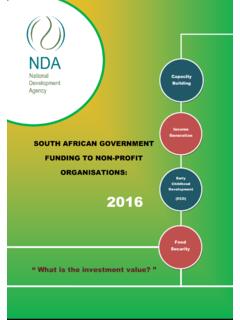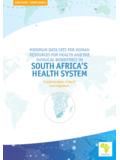Transcription of CHALLENGES FACING EARLY CHILDHOOD DEVELOPMENT …
1 CHALLENGES FACING EARLY CHILDHOOD DEVELOPMENT SECTOR IN SOUTH AFRICA 18 APRIL 2012 CHALLENGES FACING THE EARLY CHILDHOOD DEVELOPMENT SECTOR IN SOUTH AFRICA A Comprehensive Research report on EARLY CHILDHOOD DEVELOPMENT to the National DEVELOPMENT Agency (NDA) Principal researcher: Eric Atmore Research Team: Lauren van Niekerk & Michaela Ashley-Cooper 18 April 2012 1 1. Introduction The majority of young children in South Africa have been negatively impacted by a range of social and economic inequalities. Apartheid and the resultant socio-economic inequalities have created a CHILDHOOD of adversity for most African children including inadequate access to health care, education, social services and quality nutrition. This has undermined the DEVELOPMENT of our youngest children.
2 Within the South African constitution, through the Bill of Rights, provision is made for children s socio-economic rights, including the right to basic education, and protection from neglect, abuse and exploitation. However, as outlined in a report by the National Children s Rights Committee (NCRC) and NPOs, South Africa still has a long way to go to effect quality of life for the majority of her children . EARLY CHILDHOOD DEVELOPMENT The national department of Education defines EARLY CHILDHOOD DEVELOPMENT (ECD) as The processes by which children from birth to nine years of age grow and thrive physically, mentally, emotionally, morally and socially . The national department of Education is responsible for the 5 to 9 year old age cohort, and the department of social DEVELOPMENT is focused on the birth to 4 year old age cohort. The department of health covers the birth to 9 year old age cohort ( department of Education, 2001).
3 There are approximately million children in the 0 to 6 year old age cohort. Of these, some million children ( ) live in circumstances of dire poverty ( department of social DEVELOPMENT , department of Education & department of health , 2004). Whilst considering the above, there is substantial international evidence indicating the benefits of providing structured and quality EARLY CHILDHOOD DEVELOPMENT (ECD) services and programmes to preschool-aged children. Providing appropriate cognitive stimulation, nutrition, care and health services during this critical DEVELOPMENT period results in: increased primary school enrolment, enhanced school performance, lower repetition and drop-out rates, reductions in juvenile crime rates, reduced remedial education costs and improved economic and social productivity in 2 adulthood.
4 These benefits produce significant social , education and economic returns to society far outweighing the returns on other forms of human capital investment. 2. Brief The National DEVELOPMENT Agency (NDA) wished to gather evidence about the EARLY CHILDHOOD DEVELOPMENT (ECD) landscape with the view to making a significant intervention in this sector and commissioned Adjunct Associate Professor Eric Atmore to produce a paper which synthesizes evidence about ECD, taking account of the present situation as well as future projections. The goal of this report is to clearly describe the ECD sector, including enrolment rates/ratios, funding flows, and the urban-rural divide amongst others. The key questions for the study include: 1. What are the CHALLENGES in infrastructure for ECD? What are the issues regarding whether it is home-based or centre-based.
5 What are the backlogs in infrastructure for ECD centres? Explore the role of municipalities, Public Works, Education, and social DEVELOPMENT on the building of infrastructure; 2. ECD Practitioners - What are the basic requirements, and what are the qualifications needed? Conditions of service; what is the overall sense of the practitioner s qualifications? 3. Nutrition - many children in ECD centres do not have access to food. Who is addressing this need? What role should the NDA play in addressing this issue? Is it through Food Security intervention? What type? 4. Institutional capacity of ECD sites - are there processes and systems to manage finances; plan, record and report on implementation of activities; develop policies for procurement, asset management, recruitment, selection and DEVELOPMENT of staff. 3 5. Norms and standards - Given the norms and standards already developed by department of social DEVELOPMENT , what set of guidelines should inform NDA interventions?
6 Are there any EARLY , intermediary and advanced models of engagement NDA can learn from or does NDA have to develop new models? The expected outcomes of the study for the NDA include: a. A comprehensive report on the status of ECD sector in the country b. Critical analysis of the CHALLENGES faced by ECD from rural and urban perspectives c. Identification of gaps that currently exist and proposed interventions including models d. Clear recommendations for the NDA with specific reference to our strategic priorities Approach and methodology followed In undertaking this task we have produced a paper that: o Determines the situation of ECD in South Africa currently, with the view to ensuring that young children have access to quality EARLY learning opportunities, taking account of the present situation as well as future demand based on projected demographic change; o incorporates a synthesis of credible and relevant South African studies; o is based on a variety of credible research papers, including the nation-wide ECD audit of 2001 and subsequent provincial audits done; the HSRC quality report on ECD; the National Treasury report on Grade R; the National Integrated Plan for EARLY CHILDHOOD DEVELOPMENT , various versions of School Realities.
7 And Education Statistics produced by the national department of Education; o identifies gaps in service provision; o reviews ECD success stories across South Africa; o reviews and assesses demographic projections for the birth to 6 year old age cohort over the next decade. In drawing up the paper, the consultant has: o undertaken a desktop study of recent critical ECD documents; o obtained input from key ECD stakeholders in South Africa; 4 o made recommendations that introduce the most effective interventions to the quality and quantity of ECD in South Africa. 3. Context of children in South Africa General information on children in South Africa In 2009, it was estimated that children make up 38% of South Africa s population. Due to labour migration and care arrangements involving extended families, it is often the case that children live separately from their parents (South African CHILD GAUGE, 2011).
8 The distribution of children across the 9 provinces is different to the distribution of adults; a large proportion of adults living in provinces that are characterised by urban cities, whereas a greater proportion of all children live in rural areas such as Limpopo, Eastern Cape and KwaZulu-Natal (South African CHILD GAUGE, 2011). It is therefore the case that many children reside in child-headed households in which all members are under the age of 18 years. Family and community networks support the growing numbers of orphaned children in our country mainly as a result of the HIV/AIDS pandemic. The General Household Survey of 2009 indicated that South Africa is home to 95,000 children living in child-headed households. These children are more at risk than others of poor access to services, inconsistent income and poor living circumstances.
9 Poverty There are a range of CHALLENGES and obstacles FACING children and their families, teachers, communities and government. One of the major CHALLENGES is that of poverty (UNICEF, 2009). More than half of South Africa s children live in severe poverty which jeopardises the realisation of their rights as contained in the South African Constitution (Du Plessis & Conley, 2007). Poverty and inequality in South Africa is worsening at a startling rate (Du Plessis & Conley, 2007). Children living in poverty are extremely vulnerable and often discriminated against and isolated. In South Africa, the majority of children do not have access to an EARLY education programme as many parents and/or families cannot afford to pay for school fees. UNICEF records that is 5 important that government departments collaborate to enhance the accessibility of EARLY CHILDHOOD DEVELOPMENT programmes for young children (UNICEF, 2009).
10 The South African Constitution acknowledges that children have the right to social assistance when their families are unable to meet their basic needs. It is clear that income poverty is closely connected to poor health , limited access to education, nutrition, healthcare services and safe environments. The General Household Survey, of 2009, showed that 61% of children in South Africa lived below the poverty line (with a per capita income below R522 per month). Closely linked to this income poverty indicator is unemployment. Stats SA (2010) indicated that 36% of children reside in households where no adults are employed. Government does provide financial support to children when their mothers are too poor to do so, in order for them to meet their basic needs. This financial support is provided through social assistance programmes such as the Child Support Grant, paid to the caregivers of eligible children.








